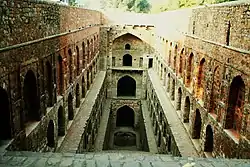Agrasen
Maharaja Agrasen was a legendary Indian king (Maharaja) of Agroha, a city of traders. He is credited with the establishment of a kingdom of traders in North India named Agroha, and is known for his compassion in refusing to slaughter animals in yajnas.
| Agrasen | |
|---|---|
| Maharaja Agrasen | |
| Predecessor | Maharaja Vallabh |
| Successor | Vibhu |
| Consort | Maharani Madhavi |
| Issue | Vibhu |
| Father | Maharaja Vallabh |
| Mother | Bagwati Devi |
| Religion | Hinduism, also revered by some Agrahari Sikhs |
The Government of India issued a postage stamp in honour of Maharaja Agrasen in 1976.[1][2]

Origin of the legend
The Agrasen legend can be traced to Agarwalon ki Utpatti ("Origin of the Agrawals"), an 1871 essay written by Bharatendu Harishchandra (1850-1885), a noted Agrawal author and poet. He claimed to have compiled the legend from "tradition" and "ancient writings", especially a text called Sri Mahalakshmi Vrat Ki Katha. He stated that Sri Mahalakshmi Vrat Ki Katha was contained in the Bhavishya Purana, which exists in several recensions. However, independent researchers have been unable to find the legend in any version of Bhavishya Purana.[5]
In 1976, the Agrawal historian Satyaketu Vidyalankar published a copy of the Mahalakshmi Vrat Ki Katha in his Agrwal Jati Ka Prachin Itihas ("Ancient History of the Agrawal caste"). He stated that he had found this copy in the personal library of Bharatendu Harishchandra. However, the text does not contain any clue about its origin.[5]
Legends and beliefs
Agrasen was a vysya king of the Solar Dynasty who adopted Vanika dharma for the benefit of his people.[6][7] Literally, Agrawal means the "children of Agrasen" or the "people of Agroha", a city in ancient Kuru Panchala, near Hisar in Haryana region said to be founded by Agrasen.[8]
He is said to have married 17 naga-kanyas.[9]
Agrawal gotras
According to Bharatendu Harishchandra's narrative, the Agrawals are divided into seventeen and a half gotras (exogamous clans), which came into being from seventeen and a half sacrifices performed by Agrasen. The last sacrifice is considered "half" because it was abandoned after Agrasen expressed remorse for the violent animal sacrifices. Bharatendu also mentions that Agrasen had 17 queens and a junior queen, but does not mention any connection between these queens and the formation of the gotras. Neither does he explain how sacrifices led to the formation of the gotras.[10] Another popular legend claims that a boy and girl from the Goyal gotra married each oher mistake, which led to the formation of a new "half" gotra.[11]
Historically, there has been no unanimity regarding number and names of these seventeen and a half gotras, and there are regional differences between the list of gotras. The Akhil Bhartiya Agrawal Sammelan, a major organization of Agrawals, has created with a standardized list of gotras, which was adopted as an official list by a vote at the organization's 1983 convention.[12] Because the classification of any particular gotra as "half" is considered insulting, the Sammelan provides a list of following 18 gotras:[13]
- Bansal
- Mittal
- Kucchal
- Kansal
- Bindal
- Dharan
- Singhal
- Jindal
- Goyal
- Tingal
- Tayal
- Garg
- Bhandal
- Nangal
- Mangal
- Airan
- Madhukul
- Goyan
See also
References
- Maharaja Agrasen Dak Ticket Samaroh ki kuchh Yaden, Omprakash Agrawal, Agradhara, Sept 2016, p. 32
- "KCR Praises Vaisyas to Skies, Says The Community Knows Art of Life".
- "Agrasen Ki Baoli". AgrasenKiBaoli.com. Retrieved 4 August 2015.
- Mittal, J.P. (2006), History of Ancient India (4250 BC to 637 AD) page 675, ISBN 978-81-269-0616-1 (This author considers King Agrasen an actual historical figure)
- Lawrence A. Babb 2004, p. 199.
- Singh, Kumar Suresh; B. V. Bhanu (2004). People of India. Popular Prakashan (Mumbai), Anthropological Survey of India (Kolkata). p. 46. ISBN 81-7991-100-4. OCLC 58037479. Retrieved 19 April 2007.
- History of Ancient India - By J.P. Mittal
- Speeches and Writings by Har Bilas Sarda
- Bombay Presidency Gazetteer, 1885, pages 262–263
- Lawrence A. Babb 2004, pp. 201-202.
- M. S. Gore 1990, p. 69.
- Lawrence A. Babb 2004, pp. 193-194.
- Lawrence A. Babb 2004, p. 192.
Bibliography
- Lawrence A. Babb (2004). Alchemies of Violence: Myths of Identity and the Life of Trade in Western India. SAGE. ISBN 978-0-7619-3223-9.
- M. S. Gore (1990). Urbanization and Family Change. Popular Prakashan. ISBN 978-0-86132-262-6.
External links
- Maharaja Agrasen at agrasen.com